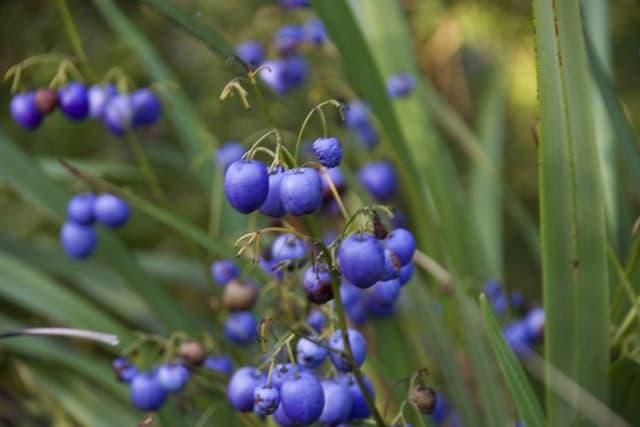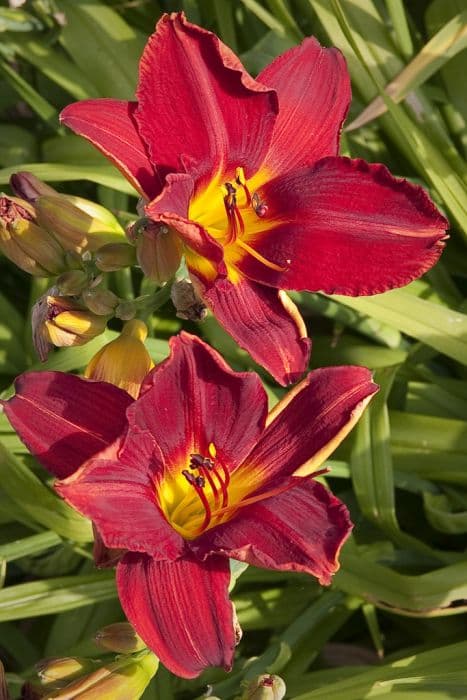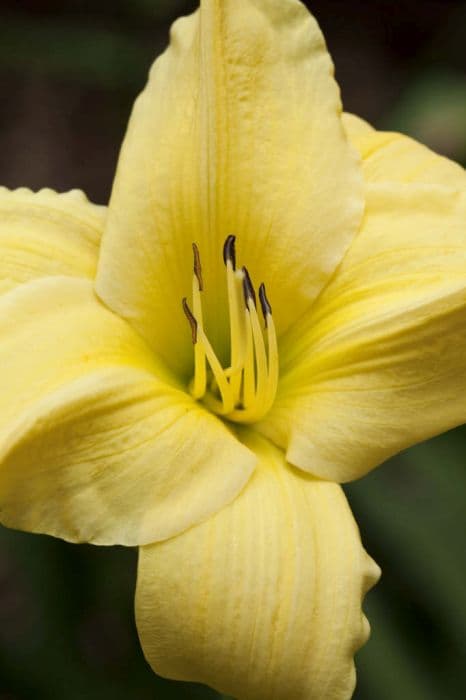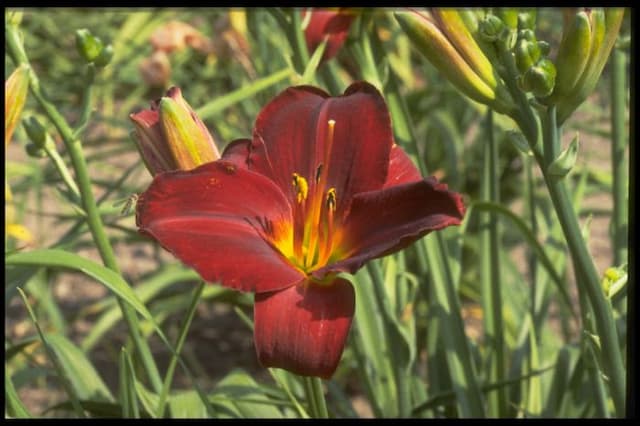Variegated New Zealand Flax Phormium tenax 'Variegatum' (v)

ABOUT
Commonly known as the variegated New Zealand flax, Phormium tenax 'Variegatum' is distinctive for its robust, sword-shaped leaves that boast a striking combination of colors. The foliage displays a rich green base with creamy yellow to white stripes running lengthwise, creating a pattern that stands out in garden settings. These bold stripes may vary in width across the leaves, adding to the plant's dramatic variegation and visual interest. The stiff leaves emerge from a clump at the base and typically arch outward gracefully. In some conditions, the plant may produce clusters of tubular flowers on long stems that rise prominently above the foliage, adding a vertical element to its form. The flowers can attract birds and insects, enriching the environmental interactions around the plant. With its flamboyant foliage and potential blooms, the variegated New Zealand flax becomes a focal point wherever it is planted. It remains evergreen throughout the seasons, providing year-round visual appeal.
About this plant
 Names
NamesSynonyms
Variegated New Zealand Flax, Variegated Flax Lily, Striped Wild Iris.
Common names
Phormium tenax 'Variegata', Phormium colensoi 'Variegatum', Phormium cookianum 'Variegata'.
 Toxicity
ToxicityTo humans
The New Zealand Flax is not considered toxic to humans. However, like many plants, it may cause irritation or an allergic reaction if sensitive individuals handle it or ingest it. It is not generally associated with serious poisoning or severe symptoms if ingested in small amounts.
To pets
The New Zealand Flax is not typically toxic to pets. However, ingestion of any plant material can potentially lead to gastrointestinal upset, such as vomiting or diarrhea, in some animals if they are not used to it or if they consume large amounts. Care should always be taken to prevent pets from ingesting plants, as individual animals may have unique sensitivities or allergic reactions.
 Characteristics
CharacteristicsLife cycle
Perennials
Foliage type
Evergreen
Color of leaves
Variegated
Flower color
Red
Height
6-10 feet (1.8-3 meters)
Spread
5-8 feet (1.5-2.4 meters)
Plant type
Shrub
Hardiness zones
8-11
Native area
New Zealand
Benefits
 General Benefits
General Benefits- Ornamental Value: Adds visual interest to gardens with its striking variegated foliage.
- Drought Tolerance: Once established, it requires minimal water, making it suitable for dry climates and water-conservative landscaping.
- Low Maintenance: Requires little care beyond occasional trimming, ideal for gardeners seeking minimal upkeep plants.
- Wind Resistance: Sturdy leaves and strong root system make it an excellent choice for windy sites or coastal gardens.
- Soil Adaptability: Can thrive in a range of soil conditions, from sandy to clay, as long as the site is well-drained.
- Erosion Control: Its root structure helps stabilize soil, making it beneficial for planting on slopes or banks to prevent erosion.
- Pest Resistance: Generally resistant to pests and diseases, reducing the need for chemical treatments.
- Architectural Plant: Provides structure and a focal point in garden designs, especially in modern or contemporary landscapes.
- Habitat Support: Flowers provide nectar for birds and bees, supporting local wildlife and biodiversity.
 Medical Properties
Medical Properties- This plant is not used for medical purposes.
 Air-purifying Qualities
Air-purifying QualitiesThis plant is not specifically known for air purifying qualities.
 Other Uses
Other Uses- New Zealand Flax 'Variegatum' can be used for manufacturing strong, durable textiles such as bags and mats due to its tough, fibrous leaves.
- The fibers of the plant can be used in papermaking, providing a unique texture and strength to handmade papers.
- As an ornamental plant, New Zealand Flax 'Variegatum' is used in landscaping for its striking foliage and architectural form that provides visual interest in gardens.
- The plant can be applied in weaving crafts, where its fibers are used to create traditional Māori kete (baskets) and whāriki (mats).
- Its waterproof qualities make New Zealand Flax 'Variegatum' suitable for making rain capes and cloaks in traditional contexts.
- The rigid leaves can be used as garden ties, offering a natural alternative to plastic or metal ties for supporting other plants.
- New Zealand Flax 'Variegatum' is used as a natural dye source for textiles, giving a range of colors from greens to yellows depending on the mordant used.
- The flowering stalks can be used in large floral arrangements, providing an exotic and long-lasting element to the design.
- When dried, the seed pods can be utilized in creating musical instruments like rattles, adding a natural sound element to performances.
- The plant's ability to withstand coastal conditions makes it an excellent choice for erosion control in seaside landscapes.
Interesting Facts
 Feng Shui
Feng ShuiThe New Zealand Flax is not used in Feng Shui practice.
 Zodiac Sign Compitability
Zodiac Sign CompitabilityThe New Zealand Flax is not used in astrology practice.
 Plant Symbolism
Plant Symbolism- Strength - The tough, sword-shaped leaves of Phormium tenax 'Variegatum', commonly known as Variegated New Zealand Flax, signifies resilience and the ability to withstand harsh conditions.
- Versatility - This plant's varied uses, from its fibrous leaves used in weaving to its ornamental value, represent adaptability and resourcefulness.
- Endurance - Given its capacity to thrive in coastal environments, the Variegated New Zealand Flax is often associated with enduring and persisting through challenges.
 Water
WaterNew Zealand Flax requires consistent watering, especially during hot and dry periods. It is best to water deeply every week, providing about 1 gallon of water per plant. Ensure that the soil is kept moist but not waterlogged, as this plant is drought tolerant once established. During the winter months, water sparingly, allowing the soil to dry out between watering. It’s crucial to avoid overwatering, as it can lead to root rot.
 Light
LightNew Zealand Flax thrives in full sun to partial shade conditions. It prefers a location where it can receive at least six hours of sunlight daily, though it can tolerate some light shade. Ensure it's planted in a spot where it can get ample morning light, which is less intense, and some afternoon shade if you live in an area with very hot summers.
 Temperature
TemperatureNew Zealand Flax prefers temperate climates with temperatures ranging between 50 and 75 degrees Fahrenheit. It can handle temperatures as low as 20 degrees Fahrenheit but should be protected from hard frosts. Ideally, maintain a consistent temperature above freezing to encourage healthy growth and avoid any damage to the foliage.
 Pruning
PruningNew Zealand Flax should be pruned to remove any damaged or dead foliage and to maintain its shape. Pruning is best done in the early spring before new growth starts. Cut back foliage selectively, and remove spent flower stalks to redirect the plant's energy. Pruning can be done annually or as needed to keep the plant looking tidy.
 Cleaning
CleaningAs needed
 Soil
SoilNew Zealand Flax 'Variegatum' prefers well-draining soil with a slightly acidic to neutral pH, typically between 5.5 to 7.0. A good soil mix can be created by blending equal parts of loamy soil, peat, and coarse sand or perlite to ensure proper drainage and aeration.
 Repotting
RepottingNew Zealand Flax 'Variegatum' typically requires repotting every 2 to 3 years. The best time to repot is in the spring or early summer which gives the plant time to reestablish in the new pot before the colder months.
 Humidity & Misting
Humidity & MistingNew Zealand Flax 'Variegatum' is tolerant of a wide range of humidity levels and does not require any specific humidity conditions, making it very adaptable to typical indoor environments.
 Suitable locations
Suitable locationsIndoor
Place New Zealand Flax in bright, indirect light inside.
Outdoor
Plant in sun to partial shade, protect from strong winds outdoors.
Hardiness zone
8-11 USDA
 Life cycle
Life cycleNew Zealand Flax 'Variegatum' begins its life as a seed, which, when sowed in well-drained soil and given the right conditions, will germinate and sprout. The seedling then develops into a clump of striking variegated leaves, with creamy stripes along the margins of a green central stripe. As the plant matures, it forms a robust evergreen perennial structure, characterized by its sword-shaped leaves and toughness against coastal and windy conditions. Between late spring and midsummer, mature New Zealand Flax plants may shoot up tall flower spikes with tubular, yellow or red flowers, which are attractive to birds and insects. After pollination, flowers give way to capsules that contain seeds for the next generation. Over many years, the plant can become quite large, eventually needing division to rejuvenate and maintain vigor.
 Propogation
PropogationPropogation time
Spring-Early Summer
The most popular method of propagating New Zealand Flax 'Variegatum' is by division. This process is typically carried out in the spring as the plant comes out of dormancy or in the early fall when the weather is cool but the soil is still warm. One would carefully lift the parent plant from the ground using a spade, ensuring to get as much of the root system as possible. Using a sharp knife or a spade, the clump is then divided into smaller sections, each with at least one growing point or fan of leaves. The new divisions should be planted immediately at the same depth they were originally growing, and it's important to water them well to help establish the roots. Taking care to minimize trauma to the plant during this process will better ensure successful establishment of the new plants.









